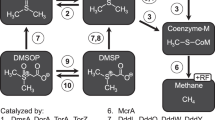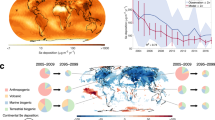Abstract
The emission of biogenic sulphur gases constitutes about half the atmospheric budget for gaseous sulphur1. Since dimethylsulphide (DMS) was first implicated as a major component of gaseous sulphur flux2–4, considerable attention has been given to its emission from various ecosystems. Salt marshes have been identified as one system with a high area-specific sulphur emission5–13. Dimethylsulphide and hydrogen sulphide (H2S) constitute the bulk of the flux from salt marshes, with DMS predominating in vegetated areas of the marsh6,8–13. As H2S is a product of anaerobic decomposition in sediments, it has been assumed that other sulphur gases emitted from salt marshes also originate from decomposition in sediment processes5. Our research suggests an alternative explanation for DMS fluxes. We have investigated the distribution of DMS and dimethy Isulphoniopropionate (DMSP) in salt marshes and conclude that DMS arises primarily from physiological processes in leaves of higher plants, mainly one species of grass, Spartina alterniflora. Furthermore, the emission of DMS from this grass may be influenced by the technique used to measure emission, and emission from sites dominated by S. alterniflora cannot be considered to be representative of marsh flora.
This is a preview of subscription content, access via your institution
Access options
Subscribe to this journal
Receive 51 print issues and online access
$199.00 per year
only $3.90 per issue
Buy this article
- Purchase on Springer Link
- Instant access to full article PDF
Prices may be subject to local taxes which are calculated during checkout
Similar content being viewed by others
References
1. Andreae, M. O. & Raemdonck, H. Science 221, 744-747 (1983). 2. Lovelock, J. E., Maggs, R. J. & Rasmussen, R. A. Nature 237, 452-453 (1972). 3. Liss, P. S. & Slater, P. G. Nature 247, 181-184 (1974). 4. Maroulis, P. J. & Bandy, A. R. Science 196, 647-648 (1977). 5. Hitchcock, D. Chemosphere 3, 137-138 (1975). 6. Adams, D. F., Harwell, S. O., Robinson, E., Pack, M. R. & Bamesberger, W. L. Envir. Sci. Technol. 15, 1439-1498 (1981). 7. Aneja, V. P., Aneja, A. P. & Adams, D. F. /. air Pollut. Control Ass. 32, 803-807 (1982). 8. Goldberg, A. B., Maroulis, P. J., Wilner, L. A. & Bandy, A. R. Atmos. Envir. 15,11-18 (1981). 9. Steudler, P. A. & Peterson, B. J. Nature 311, 455-457 (1984). 10. Steudler, P. A. & Peterson, B. J. Atmos. Envir. 19, 1411-1416 (1985). 11. Jorgensen, B. B. & Okholm-Hansen, B. Atmos. Envir. 11, 1737-1749 (1985). 12. Cooper, D. J. el al. Atmos. Envir. 21, 7-12 (1987). 13. de Mello, W. Z. el al. Atmos. Envir. 21, 987-990 (1987). 14. King, G. M., Howes, B. L. & Dacey, J. W. H. Geochim. cosmochim. Acta 49,1561-1566 (1986). 15. Howes, B. L., Dacey, J. W. H. & Wakeham, S. G. Limnol. Oceanogr. 30, 221-227 (1985). 16. Challenger, F. Aspects of the Organic Chemistry of Sulfur (Academic, New York, 1959). 17. Reed, R. H. Mar. Biol. Lett. 4, 173-181 (1983). 18. White, R. H. / mar. Res. 40, 529-536 (1982). 19. Larher, F., Hamelin, J. & Stewart, G. R. Phytochemistry 16, 2019-2020 (1977). 20. van Diggelen, J., Rozema, J., Dickson, D. M. J. & Broekman, R. New Phytol. 103, 573-586 (1986). 21. Wyn Jones, R. G. & Storey, R. in the Physiology and Biochemistry of Drought Resistant Plants (eds Paleg, L. G. & Aspinall, D.) 171-204 (Academic, Sydney, 1982). 22. Nriagu, J. O., Holdway, D. A. & Coker, R. D. Science 237, 1189-1192 (1987). 23. Andreae, M. O. & Andreae, T. W. J. geophys. Res. (in the press). 24. Vairavamurthy, A., Andreae, M. O. & Iverson, R. L. Limnol. Oceanogr. 30, 59-70 (1985). 25. Dacey, J. W. H. & Wakeham, S. G. Science 233, 1314-1316 (1986). 26. Winner, W. E. et al. Nature 289, 672-673 (1981).
Author information
Authors and Affiliations
Rights and permissions
About this article
Cite this article
Dacey, J., King, G. & Wakeham, S. Factors controlling emission of dimethylsulphide from salt marshes. Nature 330, 643–645 (1987). https://doi.org/10.1038/330643a0
Received:
Accepted:
Issue Date:
DOI: https://doi.org/10.1038/330643a0
This article is cited by
-
Microbial drivers of DMSO reduction and DMS-dependent methanogenesis in saltmarsh sediments
The ISME Journal (2023)
-
Dimethylsulfoniopropionate and dimethylsulfoxide in Posidonia oceanica
Marine Biology (2021)
-
Bacteria are important dimethylsulfoniopropionate producers in coastal sediments
Nature Microbiology (2019)
-
Bacterial SBP56 identified as a Cu-dependent methanethiol oxidase widely distributed in the biosphere
The ISME Journal (2018)
-
Weak Correlation Between Methane Production and Abundance of Methanogens Across Three Brackish Marsh Zones in the Min River Estuary, China
Estuaries and Coasts (2015)
Comments
By submitting a comment you agree to abide by our Terms and Community Guidelines. If you find something abusive or that does not comply with our terms or guidelines please flag it as inappropriate.



